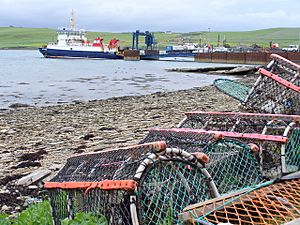Houton facts for kids
Quick facts for kids Houton |
|
|---|---|
 The Bay of Houton, showing ferry terminal and lobster pots |
|
| OS grid reference | HY317041 |
| Civil parish | |
| Council area | |
| Lieutenancy area | |
| Country | Scotland |
| Sovereign state | United Kingdom |
| Post town | ORKNEY |
| Postcode district | KW17 |
| Dialling code | 01856 |
| Police | Northern |
| Fire | Highlands and Islands |
| Ambulance | Scottish |
| EU Parliament | Scotland |
| UK Parliament |
|
| Scottish Parliament |
|
Houton is a small village located on the beautiful Mainland island in Orkney, Scotland. It's about 5 miles (8 kilometers) southeast of the town of Stromness. Houton is part of the area known as Orphir and can be found along a smaller road off the main A964 road.
This village is an important spot because it has a ferry terminal. From here, you can catch a ferry to Lyness on the island of Hoy or to the oil terminal at Flotta.
Contents
Exploring Houton's History
Near Houton, you can discover some fascinating historical sites. These places are looked after by Historic Environment Scotland, which helps protect Scotland's past.
The Unique Round Church
One special place is the Orphir Round Church. It's dedicated to St Nicholas and is the only medieval round church in all of Scotland! A medieval church means it was built a very long time ago, during the Middle Ages.
Earl's Bu Ruins
Close to the church are the ruins of the Earl's Bu. This was once a grand manor house. It belonged to the Earldom of Orkney, which was a powerful historical title.
The Holm of Houton
Also nearby is the Holm of Houton. A "holm" is a small, low island, especially one in a river or close to a larger island.
Houton's Airfield Story
Houton also has a connection to aviation history. There was once an air base here called RAF Houton. RAF stands for Royal Air Force.
World War I Seaplanes
During World War I, RAF Houton was an important base for seaplanes. These are planes that can land on and take off from water. The base was home to different flying units. For example, a special training flight for seaplanes was set up here in 1918. They used large seaplanes like the Felixstowe F.3 and the Curtiss H.16 to train pilots. This training flight was active for a few months before the war ended.
RAF Houton played a role in defending the area and training airmen during that time.


